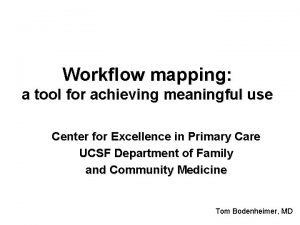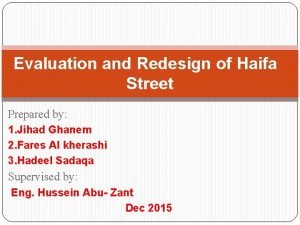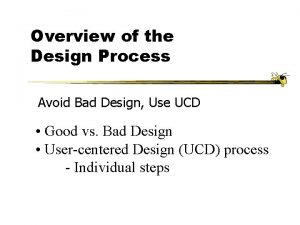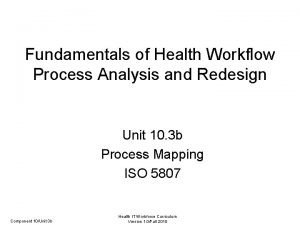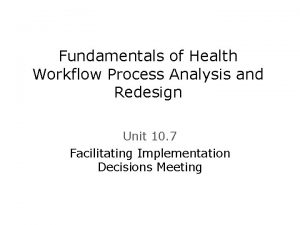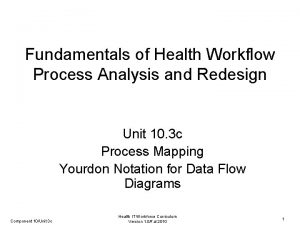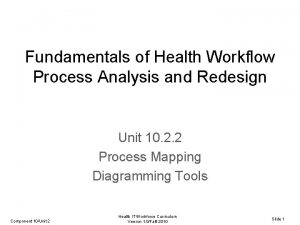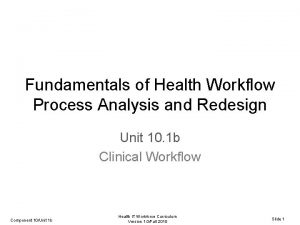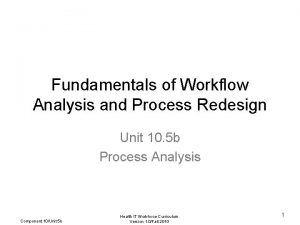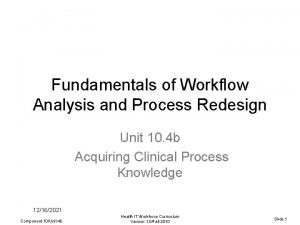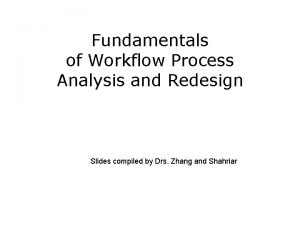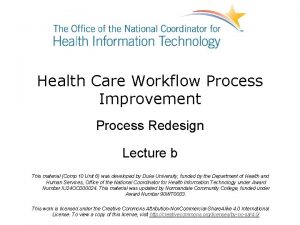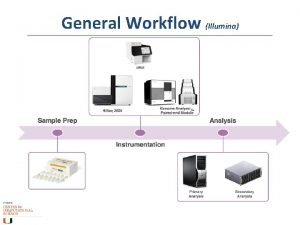Fundamentals of Health Workflow Process Analysis and Redesign


















- Slides: 18

Fundamentals of Health Workflow Process Analysis and Redesign Unit 10. 3 d Process Mapping Gane-Sarson Notation Component 10/Unit 3 d Health IT Workforce Curriculum Version 1. 0/Fal 2010 1

Upon successful completion of this sub-unit the student is able to: • Describe Gane-Sarson notation (symbols and conventions) for process diagramming. • Read a data flow diagram in Gane-Sarson notation and describe the information generated and used, and the path of that information through the system. Component 10/Unit 3 d Health IT Workforce Curriculum Version 1. 0/Fal 2010 2

Methods for Diagramming Processes Process Aspects ISO 5807 Context Process steps X Data flow steps X Information content Data transformation X Flow control and state X Roles involved X Component 10/Unit 3 d Yourdon Gane. Sarson UML X X X E-R diagram X X text X x x X text X Health IT Workforce Curriculum Version 1. 0/Fal 2010 X X 3

Background • Gane-Sarson notation was introduced in Chris Gane and Trish Sarson’s 1977 book Structured Systems Analysis: Tools and Techniques • Gane-Sarson notation is used for data flow diagrams. • Although we have not seen Gane-Sarson notation used in healthcare, this notation is used in systems analysis and health IT analysts might encounter Gane-Sarson style diagrams. Component 10/Unit 3 d Health IT Workforce Curriculum Version 1. 0/Fal 2010 4

Use • Gane-Sarson notation is specific to data flow diagrams to show the movement, transformation and storage of data. Component 10/Unit 3 d Health IT Workforce Curriculum Version 1. 0/Fal 2010 5

Simplified On-line Appointment Scheduling Example Patient Accept / decline request Web inquiry 1 Check appointment availability Inquiry / reply Office schedule 2 Check current patient Component 10/Unit 3 d Inquiry / reply Health IT Workforce Curriculum Version 1. 0/Fal 2010 Admin. database 6

Gane-Sarson Symbols Entity Double square 1 Process Data flow Data store Component 10/Unit 3 d Rounded rectangle Arrow Open-ended rectangle Health IT Workforce Curriculum Version 1. 0/Fal 2010 7

Entities Entity Nurse Entity Patient Entity Nurse • Entities – represent people, organizations, or other things that interact with the system. – send or consume information • If the same entity is shown more than once in a diagram, a diagonal line is added to the lower right-hand corner to visually distinguish it Medical Entity assistant Component 10/Unit 3 d Health IT Workforce Curriculum Version 1. 0/Fal 2010 Medical Entity assistant 8

1 Process Assess patient • Processes transform data • Process should be named or described with a single word (a verb), phrase, or simple sentence that describes what the process does. • Similar to other notations, a good name will generally consist of a verb-object phrase such as check availability. • In some cases, the process are named for a role, an organization, or a machine that performs the process. Component 10/Unit 3 d Health IT Workforce Curriculum Version 1. 0/Fal 2010 9

Flow prescription • A data flow is a pipe through which data travel • Straight lines indicate flow or movement of information • Flow names indicate the meaning of the data that moves along the flow. • A flow can: – represent only one type of data, e. g. , request or reply , OR – consolidate several elementary data flows into one flow, e. g. , request and reply • the same content may have a different meaning in different parts of the system • Every line needs an arrow head to indicate direction of the data flow Component 10/Unit 3 d Health IT Workforce Curriculum Version 1. 0/Fal 2010 10

Data Store EMR • A collection of data at rest • Can be in computerized or noncomputerized format • Stores are passive; processes put data in or read data D 1 Claims database Component 10/Unit 3 d Health IT Workforce Curriculum Version 1. 0/Fal 2010 11

Event List ? • Unlike Yourdon notation, Gane-Sarson does not use an event list to indicate things that stimulate action from the system. • Things that stimulate action from a system are indicated by entities. Component 10/Unit 3 d Health IT Workforce Curriculum Version 1. 0/Fal 2010 12

Diagram Levels • Diagram levels are – a roll-up and drill-down – functional decomposition is used to represent each process in more detailed steps / processes • Context diagram is highest level • There as many lower-levels as needed Component 10/Unit 3 d Health IT Workforce Curriculum Version 1. 0/Fal 2010 13

Conventions • • Meaningful names Number processes and data stores Make sure the DFD is internally consistent and consistent with any associated DFDs. Exceptions are shown on lower-level diagrams Component 10/Unit 3 d Health IT Workforce Curriculum Version 1. 0/Fal 2010 14

Aesthetics • The size of the shapes should be consistent throughout the diagram. – This limits the length of the name • Color shading for shapes and arrows may be used to visually show different types of entities, processes, data stores or flows. • Arrows in Gane-Sarson are straight and horizontal or vertical. Component 10/Unit 3 d Health IT Workforce Curriculum Version 1. 0/Fal 2010 15

Rules for Correctness • Entities may not – send data directly to other entities – send data directly to data stores – get data directly from data stores • No spontaneous data creation • No black holes Source: Ken Hopkins, Newman College, 2001 Component 10/Unit 3 d Health IT Workforce Curriculum Version 1. 0/Fal 2010 16

Maintenance • Gane-Sarson is a set of symbols and conventions named for the people who developed it. • There is no formal maintenance organization. • Individuals use and adapt it to suit their needs. Component 10/Unit 3 d Health IT Workforce Curriculum Version 1. 0/Fal 2010 17

References 1. Chris Gane and Trish Sarson, Structured Systems Analysis: Tools and Techniques, Prentice-Hall, Englewood Cliffs, NJ. 1979. Component 10/Unit 3 d Health IT Workforce Curriculum Version 1. 0/Fal 2010 18
 Procurement process redesign
Procurement process redesign Process redesign principles
Process redesign principles Heuristic process redesign
Heuristic process redesign Design and redesign of work systems
Design and redesign of work systems Job redesign job enrichment and job enlargement
Job redesign job enrichment and job enlargement Chapter 1 understanding your health and wellness
Chapter 1 understanding your health and wellness Chapter 1 understanding health and wellness
Chapter 1 understanding health and wellness Workflow process mapping for ehr implementation
Workflow process mapping for ehr implementation Tdes school
Tdes school Getting organizational redesign right
Getting organizational redesign right Bh redesign
Bh redesign Job analysis process
Job analysis process Redesign haifa
Redesign haifa Intranet redesign
Intranet redesign Redesign haifa
Redesign haifa Redesign bad honnef
Redesign bad honnef Iu job framework redesign
Iu job framework redesign Intranet redesign
Intranet redesign Technology allows for significant task redesign
Technology allows for significant task redesign







